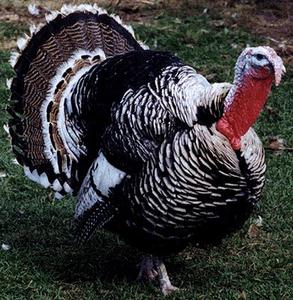Turkey Aquisition Complete!
 We went to Columbus yesterday to pick up a turkey at the North Market Poultry and Game stall. I didn’t call ahead or order one; I did that when we lived in Pataskala, but last year, because we had been focused on looking at houses in Athens, I forgot to order ahead of time, but was still able to just arrive and pick up a fresh, free-range bird.
We went to Columbus yesterday to pick up a turkey at the North Market Poultry and Game stall. I didn’t call ahead or order one; I did that when we lived in Pataskala, but last year, because we had been focused on looking at houses in Athens, I forgot to order ahead of time, but was still able to just arrive and pick up a fresh, free-range bird.
The folks at North Market Poultry are not only smart enough to order enough turkeys for walk-in customers, but they are also friendly, funny and know their products inside and out. They can rattle cooking instructions off the top of their heads that would make Julia Child proud, and they are happy to tell you where every one of thier products come from. They cook their own turkey stock on site so their customers don’t have to, and they go out of their way to sell as many Ohio-raised birds and game animals as possible, including turkeys, rabbits, bison and venison.
Well, anyway, I saw that they had standard free-range Broad-Breasted Whites in their case, as well as some heritage birds.
Heritage turkeys are the big Thanksgiving trend in the foodie world, and I have yet to try one, myself. But, seeing that there were some in the case, and noting the physical differences between the two, I decided to give one a shot.
How different are they? Well, the legs are longer on the heritage birds, and the muscle development is more evident. The breast isn’t as overwhelmingly large as the mutant-looking commercial Broad-Breasted Whites (those birds are so deformed that they can barely walk, and instead waddle awkwardly, and some cannot lift their massive breasts to walk at all) and the color of the meat was a more pinkish tone with thinner, more tightly affixed skin.
These birds are of the Narragansett breed, and were raised at Speckled Hen Farm, a poultry farm in Morrow County Ohio, not too far from Columbus. They list on LocalHarvest, and if you click on the link you can go to a great photograph of one of the owner’s kids feeding gorgeous huge turkeys some bread. Speckled Hen Farms was featured on the blog Small Farms last month, and was written up in the newsletter for Local Harvest by Tana Butler, the blogger behind Small Farms.
I have to say I am shocked at low lovely the Narragansett turkeys are from a purely aesthetic standpoint–they are very handsome birds. (The picture up above is a Narragansett male.) The males, when they strut about in their display–when they raise their tails, and puff out their feathers–are amazing in their size and color; they look something like the wily wild turkeys that roam the woodlands of Appalachia, foraging in the rolling fields and hills. I cannot help but admire their physical beauty–I did grow up going to county and state livestock shows after all, and developed an appreciation for the beauty of farm animals at an early age.
Historically speaking, the Narragansett turkeys came about when turkeys were brought from England to New England by the Puritans and then were interbred with the native wild turkeys.
I know what you are thinking–turkeys from England? I thought that they were from North America?
They were. When the Spaniards went to Mexico, they found domesticated turkeys there, and brought them back to Europe. Turkeys were among the first North American foodstuffs eagerly adopted by the Europeans, and turkey breeding took off on the continent and in England both. By the sixteenth century, turkeys were a standard part of the typical poultry yard, and so were brought with the Pilgrims, back to the colonies.
Interesting, eh?
At any rate, I am told by the good woman who sold me my very own twelve pound bird, that heritage turkeys should be cooked only to about 140 degrees internal temperature (with the thermometer in the thigh), and allowed to carry-over cook while it sits and rests for about twenty minutes. Otherwise, she said, they will dry out. Though I had heard not to brine a heritage bird, she said she brines hers and that the salt and extra moisture does nothing but enhance the already luscious native flavor of the meat. When I told her that I tend to stuff butter and fresh aromatics under the skin, then rub the skin with butter, salt and pepper, then start my bird on high heat, then turn it down after the skin browns and shrinks, she said that my method should work perfectly well for the Narragansett as well.
So, next Saturday, we shall see if my usual Thanksgiving method of combination high heat mixed with low temperature roasting will work as well with a fancy heritage bird as it does with a free-range broad-breasted white.
2 Comments
RSS feed for comments on this post.
Sorry, the comment form is closed at this time.
Powered by WordPress. Graphics by Zak Kramer.
Design update by Daniel Trout.
Entries and comments feeds.



I have a question for you–
I sent my husband out to the farm to get our turkey which we had ordered in July. He comes back home not with the 12 pounder I asked for but 2 6 pounders! I am not especially happy about this. I can’t even find any info on turkeys this small! Have you any knowledge or experience with really small free range turkeys? Will they do for 5 adults or do I send him to the supermarket to get a larger bird?
Thanks,
Cheryl
Comment by Cheryl Fuller — November 22, 2005 #
Cheryl–I already emailed you, but in case anyone else wonders–you could get enough meat off the two little turkeys for five people.
The only difference is you want to be very careful in monitoring the internal temperature of them–wee birds, even stuffed, cook much faster than larger turkeys.
On the positive side–they will be very tender, being so young.
Comment by Barbara Fisher — November 23, 2005 #